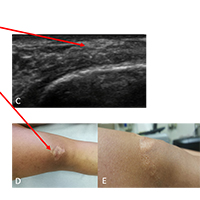 Smart Citations
Smart CitationsSee how this article has been cited at scite.ai
scite shows how a scientific paper has been cited by providing the context of the citation, a classification describing whether it supports, mentions, or contrasts the cited claim, and a label indicating in which section the citation was made.
Ultrasound imaging of a scar on the knee: Sonopalpation for fascia and subcutaneous tissues
Persistent scar pain associated with healed surgical incisions after a trauma is a common and potentially debilitating type of fascial pain. At present, there is no universally effective treatment for persistent surgical or post-trauma scar pain. Herein we describe the successful objective diagnosis of debilitating scar pain by Ultrasound (US) imaging. The sonopalpation of the fasciae and subcutaneous tissues seems to be relevant to diagnose the real cause of the pain and why not to monitor the treatment.
How to Cite
PAGEPress has chosen to apply the Creative Commons Attribution NonCommercial 4.0 International License (CC BY-NC 4.0) to all manuscripts to be published.

 https://doi.org/10.4081/ejtm.2019.8909
https://doi.org/10.4081/ejtm.2019.8909




